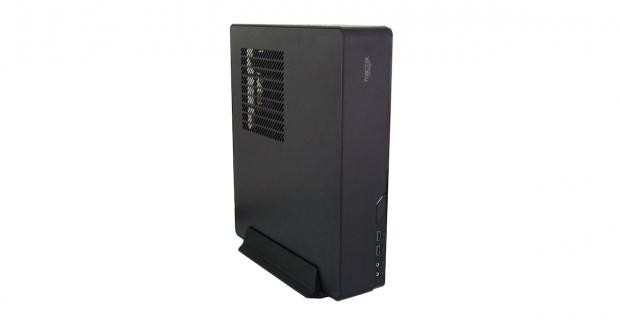
The Bottom Line
Introduction, Specifications, and Pricing
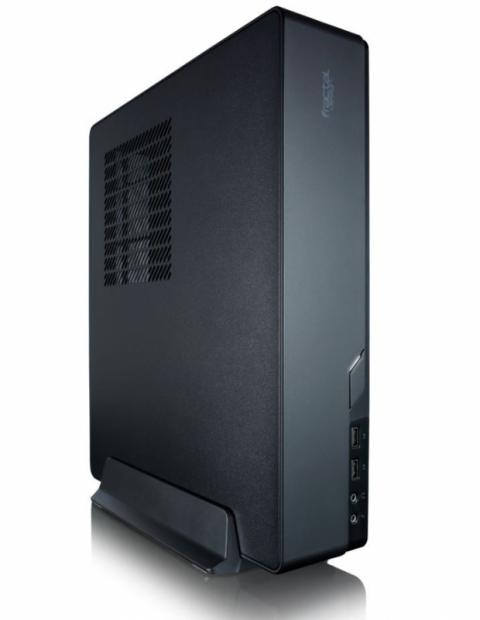
In everything we have seen from Fractal Design over the years, three things come to mind immediately. First is the fact that their cases are made of thick gauge steel, making them hefty for their size, but also makes for a near bullet proof enclosure for your hardware. Secondly, there has not been a chassis that we didn't like due to their feature sets, and the ingenuity in their designs that offers modularity and leads to easy installs. Lastly, all of their designs come in a subdued package externally. This allows any of their cases to go anywhere in the house, whether as a gamer, an email and web browsing box or even in the home theater environment, Fractal Design has an answer to any of your chassis needs.
While we just saw the Core 500, we had the opportunity to see what an SFF "shoebox" chassis is delivering these days, and we liked what we saw there too. The idea, this time, is much the same, sticking with Mini-ITX based systems, but rather than compact and squat in shape, we are moving to broad and flat design. Cases like this have been a huge hit in the realm of HTPCs or in areas where room is very limited; these media boxes have moved from an open cavity in which you haphazardly tossed parts into, to cases that are well thought out with every component being as refined as possible. Just because you may want to save room for your high horsepower PC should not mean that you have to give up on quality, and Fractal Design is proving just that in the chassis we are bringing forth today.
The chassis we are scrutinizing is the Node 202, which is available two ways. There is the standard Node 202, and Fractal Design is also offering a Node 202 plus an Integra SFX 450W PSU, which is the variant we have in hand. What sets this design apart from many other similar designs is that not only is the interior compartmentalized to improve cooling for each component, this chassis is offered as a fan-less design. While being a virtual tank of a chassis, it can lie flat or be turned on edge, resting in a provided cradle. Of course, when dealing with Fractal Design, we know there are many more additional things we could carry on about, but we will address this all in time, as we cover the Node 202 with optional Integra SFX 450W PSU, and find out just how much the Node series of cases has evolved.
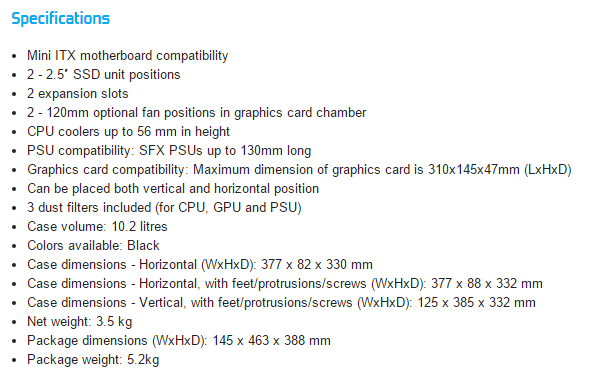
The Node 202 is made for Mini-ITX motherboards and reduces drive storage options to just two 2.5mm drives. There are two expansion slots at the back, two optional fan locations if not using a video card, it will allow the use of 56mm tall CPU coolers, and will also accept SFX power supplies up to 130mm in length. The graphics card does have some restrictions, but factory-built cards should be of no concern size wise. The chassis can be stood horizontally or vertically, and it also has three dust filters found around the chassis. The total volume of this black steel chassis is only 10.2 liters, contained within 377mm of width, 88mm of height, and 332mm of depth. All told, with the chassis empty, it weighs in at 3.5kg, which is near eight pounds.
The next section of the chart offers up information about the front I/O panel as well as the package contents. As to the front I/O panel, the Node 202 delivers two USB 3.0 ports, 3.5mm HD Audio jacks, and a large power button with an indicator light backed with a white LED. There is quite a bit that comes in the box along with the chassis as well. There is the Node 202 inside, and ours was shipped with the Integra SFX 450W PSU. There is a box of hardware, a user manual, the vertical stand that we addressed earlier, and a pair of hard riser cards that allow the graphics card to lie flat in the chassis rather than at ninety degrees to the motherboard.
There is also a large chart provided for just the Integra PSU. It is an 80 Plus Bronze rated unit with a three-year warranty and all sorts of built in protection. We also see that there is plenty when it comes to the connected PSU leads. There is the 24-pin, a four plus four 8-pin, a pair six plus two GPU connections on one lead, and the same is done with the pair of SATA connection, as they run from one lead as well. Along with the connectivity, the length of the cabling is also offered, and in this chassis, there is plenty of wiring to get any system inside powered. Lastly, there is a breakdown of the Amperage and Wattage of the individual leads, and how it received the 450W rating.
When it comes to locating the Node 202, we had no issues in doing so. Keep in mind, though, there are two variations, and the pricing moves $60 between the two models. The vanilla Node 202 can be found at Newegg and Amazon, but Newegg is selling it for just $79.99, where Amazon shows a price of $96.33. If you plan to opt for the included PSU model, while Amazon is asking $151.21, Newegg again beats that with a listing of just $139.99. Shop wisely. Whichever version you opt to go for, but from what we already know, without a power supply, the chassis is well worth the near $80 asking price, and to add in a 450W SFX power supply that is almost made specifically for a chassis this size, the $60 bump is also found to be worth it. You will run into much less conflict of the dimensions as well as not having to deal with cables that are way too long by choosing to use the Integra. We honestly do not see how you could go wrong with a chassis like the Node 202 Mini-ITX chassis whether confined in space or not.
Chad's Chassis Test System Specifications
- Motherboard: GIGABYTE GA-Z68X-UD4-B3
- CPU: Intel Core i7 2600K (buy from Amazon)
- Cooler: Corsair H80i GT (buy from Amazon)
- Memory: G.Skill Ripjaws F3-12800CL6D-4GBXH
- Video Card: ZOTAC GeForce GTX 970 AMP. Extreme Edition (buy from Amazon)
- Storage: SuperSpeed 128GB SSD
- Power Supply: SilverStone SST-ST85F-G (buy from Amazon)
- OS: Microsoft Windows 7 Ultimate 64-bit (buy from Amazon)
Packaging
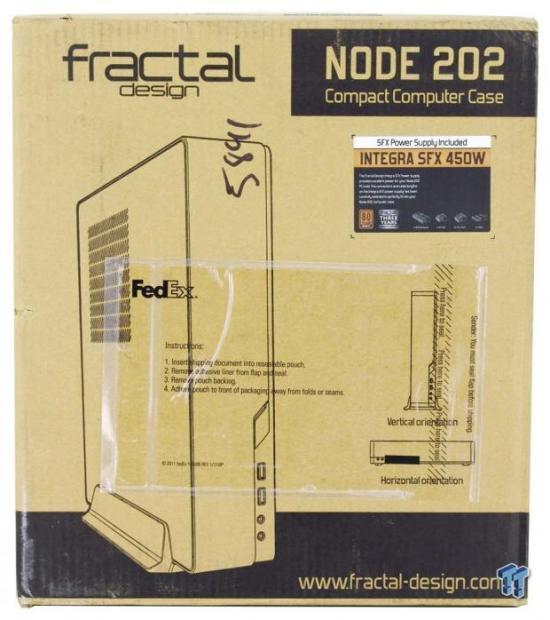
On plain cardboard, Fractal Design uses black screen printing to display the company and chassis name at the top, with a large image of the Node 202 below them. There is also a sticker on this version, denoting the inclusion of the Integra 450W SFX PSU. We also find a pair of smaller renderings showing off the orientation options, and along the bottom is the site address to obtain more information.
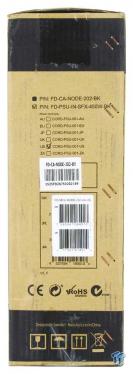
This much thinner panel offers the chassis model number along with the PSU model number, and both boxes are checked, telling us they are inside this box. The rest of the panel is used for stickers and compliances.
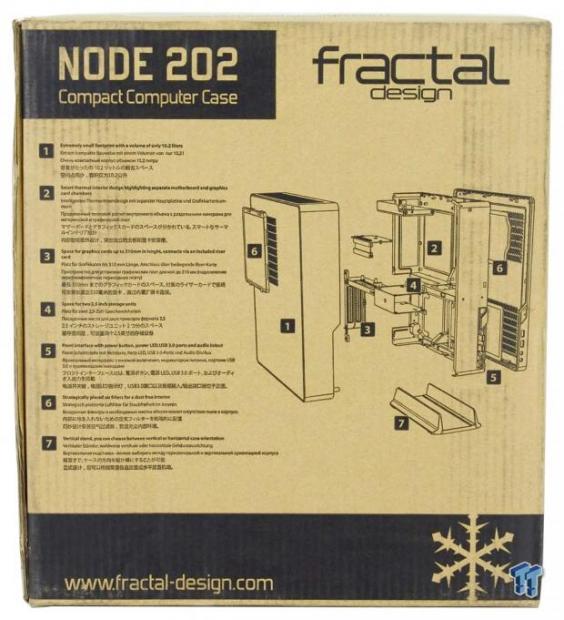
The back delivers the naming at the top again, but the rendering, this time, is an exploded diagram of the Node 202. Each component receives a number, and there is test off to the left addressing what each of these parts offers.
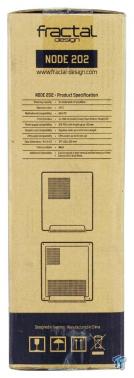
The last of the exterior panels offers a very condensed specifications chart near the top. Below the chart we see two more renderings, which show off the chassis side panels, the left one on top, and the right side panel below that.
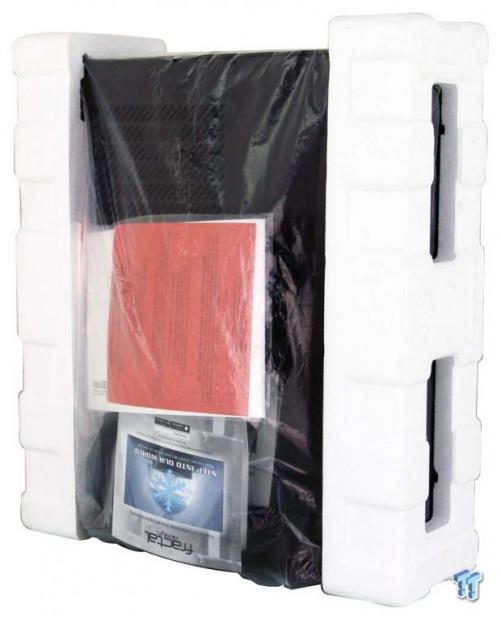
The chassis is wrapped in a plastic liner to protect the paint finish, and Fractal Design also places the paperwork in this bag, as they will not cause any damage to the chassis. The front and back of the Node 202 is covered with thick Styrofoam caps and secures this weighty chassis inside of the box. This Node 202, even with the additional weight of the SFX PSU, still showed up in perfect condition.
Fractal Design Node 202 Mini-ITX Chassis

The front of the Node 202 is flat textured matte finish along the majority of it, with shiny plastic used to the left and along the bottom. Rather than using angled corners, the Node 202 is rounded there and offers only a lightly painted Fractal Design off to the right to break up the sleek aesthetic.
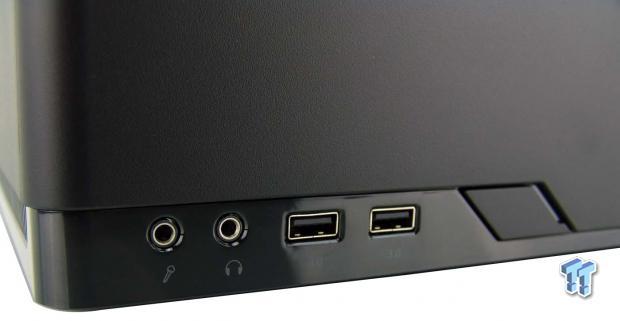
The front I/O panel is highlighted, being surrounded by the shiny plastic. In it, we find the pair of HD Audio jacks on the left, the pair of USB 3.0 ports in the middle, and the power button to the right flanked by the power LED.
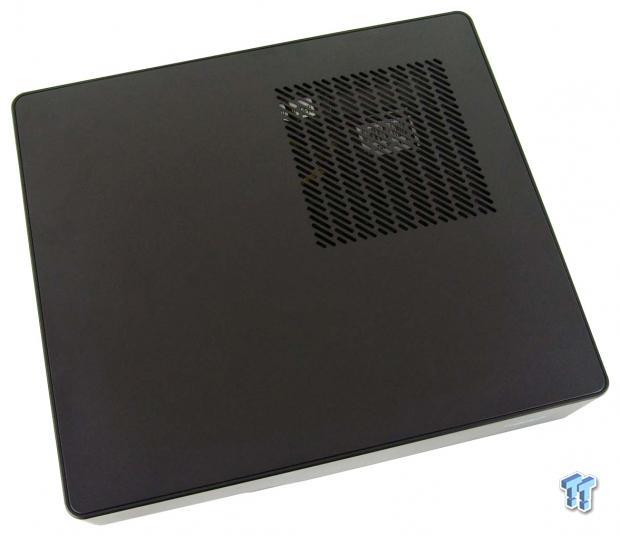
The top of the chassis is mostly solid, except for one area near the back. That angled ventilation is above the motherboard and is where your CPU air cooler is going to draw its source of cooler air.

The right side of the Node 202 offers a lot of ventilation which eats up most of this panel. To the left in this image is where the PSU exhausts, while the right side allows for the heated air from the CPU cooler to exhaust as well.

The top of the chassis covers some of the back side, as it raises and lowers between the rear I/O area and the pair of expansion slots. As we found on the front, the lower section of this chassis is made with shiny plastic trim, and on the far right is the power connection for the PSU.

The left side of the chassis is enclosed in the top section, but the lower shiny plastic near the bottom is ventilated. This allows the video card to draw air in from the side of the chassis to give it the best chance of staying cool.
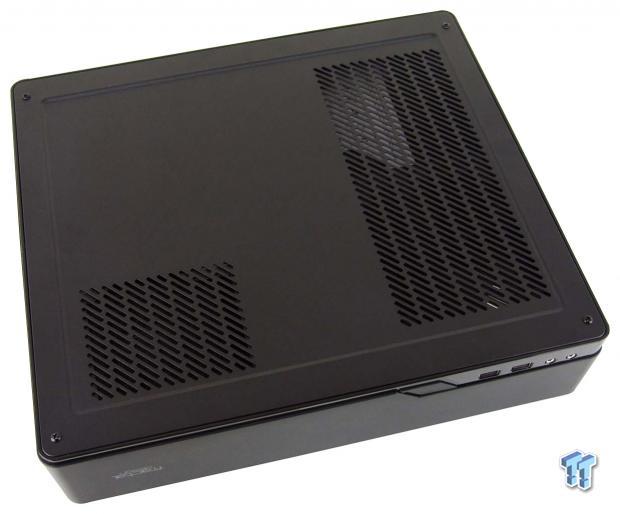
The bottom of the Node 202 offers two sections of ventilation and four screws that allow access to this case. The smaller section to the left is what allows for the PSU to draw in air, and the much larger section is under the video card, and combined with the side vent, will allow any video card to keep its cool.
Inside the Node 202
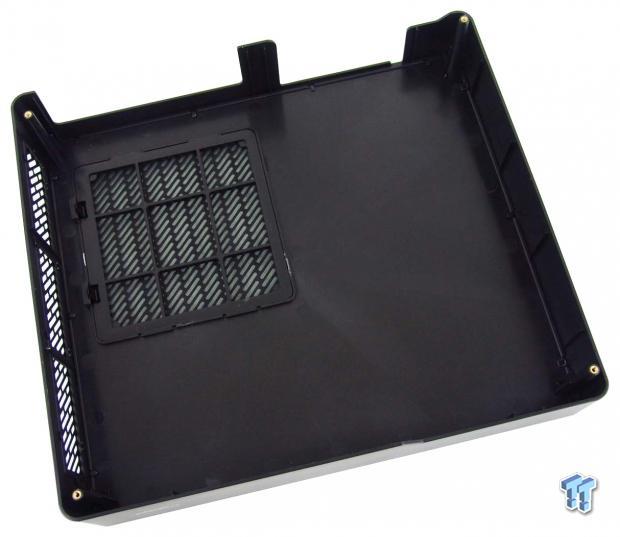
To open the Node 202, you need to remove the four screws from the bottom of the chassis, and you then flip the chassis over and remove the top cover. The large section of venting along the side, as well as the venting at the top, both come backed with a removable dust filter to make cleaning fairly easy.
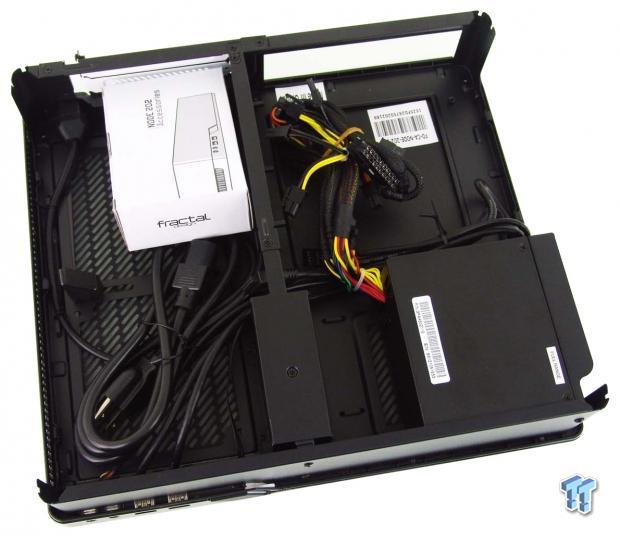
With the top of the chassis out of our way, we get our first look inside of the Node 202. In this version, we can see the PSU on the right half, and for now, let's just address finding the hardware box and the PSU power cord on the left side.

The metal frame of the Node 202 is also resting inside of a plastic cover panel, the shiny bit we saw outside of the chassis. This is clipped to the steel frame with nine tabs that need to be unlocked, allowing access to the removable dust filter for the GPU.
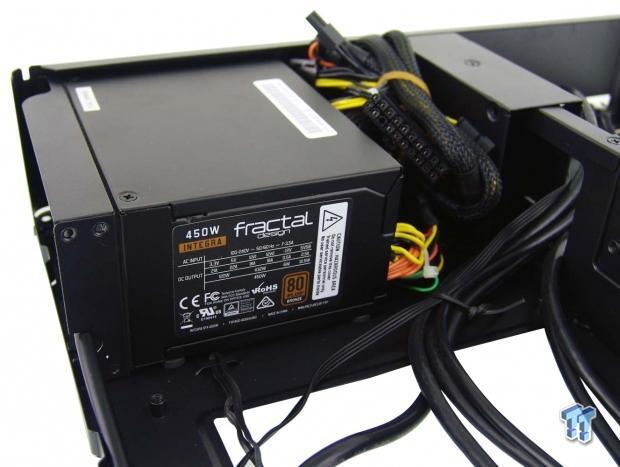
Being the front of the chassis, on the left side, since our version comes with the PSU, we find the Integra SFX 450W PSU installed, as advertised. While you can fit a longer PSU into this location, keep in mind, you do still need some room for wiring of connectivity of modular cables.
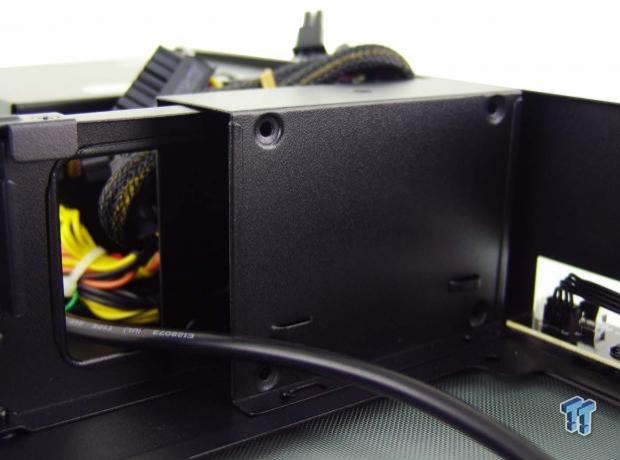
On the center support rail of the chassis, again right along the front of the Node 202, we find this dual bay cage, which is removable. This allows a 2.5" drive to be installed on either side, and the wiring is contained at the closest end, near the large wiring hole in the center rail.
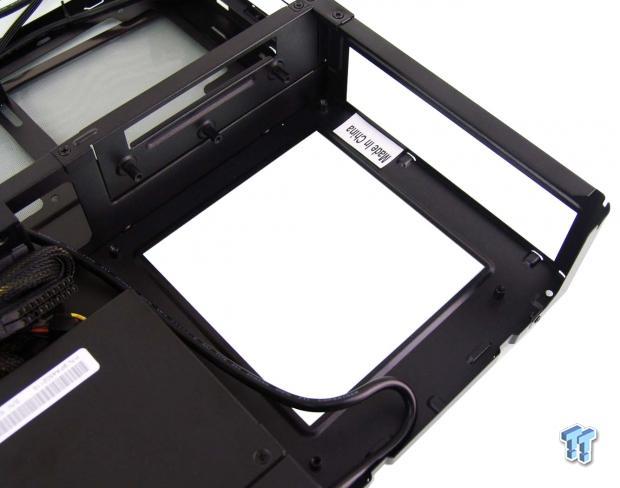
Moving towards the back of the chassis, on the same side as the PSU, we find the open-bottom motherboard tray. This will only fit Mini-ITX motherboards, but there will be no issues accessing the CPU cooler back plate.
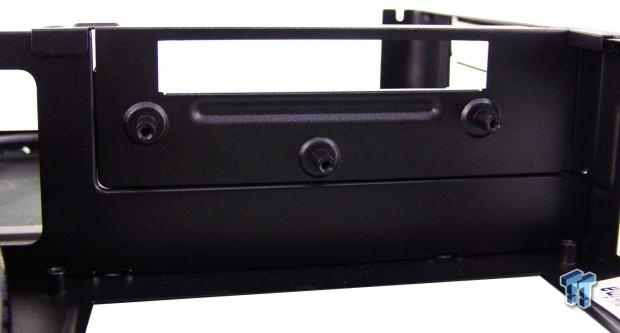
Back in that center rail, we found a removable section of steel, with three standoffs in it, and a wide hole along the top. This is used along with a pair of GPU risers, to make possible that the video card can reside on the other side of the support rail.
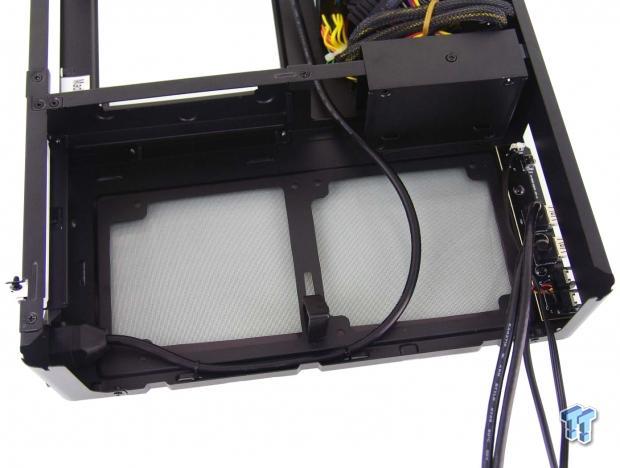
Opposite the motherboard and PSU, this entire section is dedicated to the video card. There is plenty of room for factory cooled graphics cards, custom coolers, not so much. At the front edge of the chassis, within this section, is where the front I/O is, so with longer cards you do need to address wire management, as to be sure not to encroach on room needed by the card.
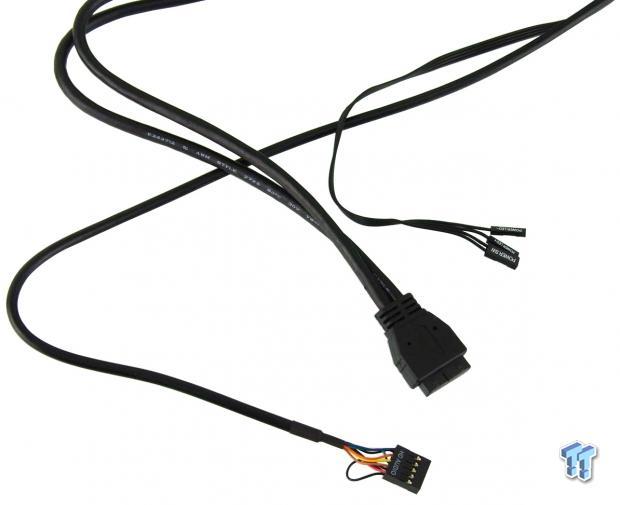
There is a long, internal, PSU power cable that delivers power from the back of the Node 202 to the front mounted PSU, but along with that is the front I/O wiring. There is length enough to get around anywhere in the chassis, yet at the same time, not too much. There are the HD Audio and native USB 3.0 connections, as well as leads for the power switch and power LED.
Hardware & Documentation
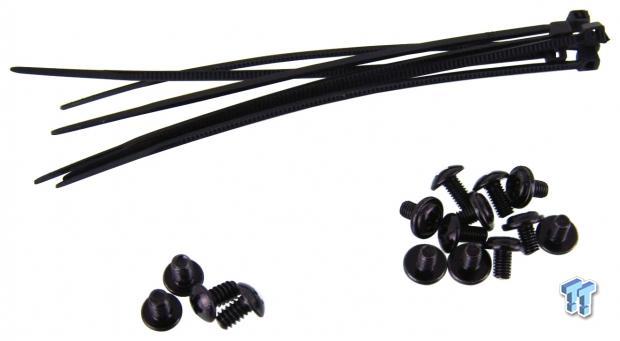
The Node 202 ships with six wire ties to address cable management on the various tie points found on the floor of the chassis. Fractal Design also includes four 6/32 thread screws, three of which are used to install the PCI-e riser card. The M3 screws on the right are used to mount the motherboard as well as being used for the 2.5" drive installations.
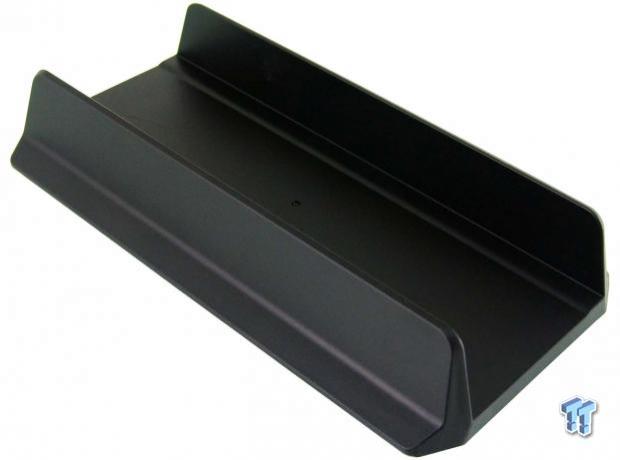
While we have shown the Node 202 in the horizontal orientation thus far, it is designed to run vertically as well, with this additional bit of kit. This thick plastic cradle will hold onto the left side of the chassis, allowing it to stand up.
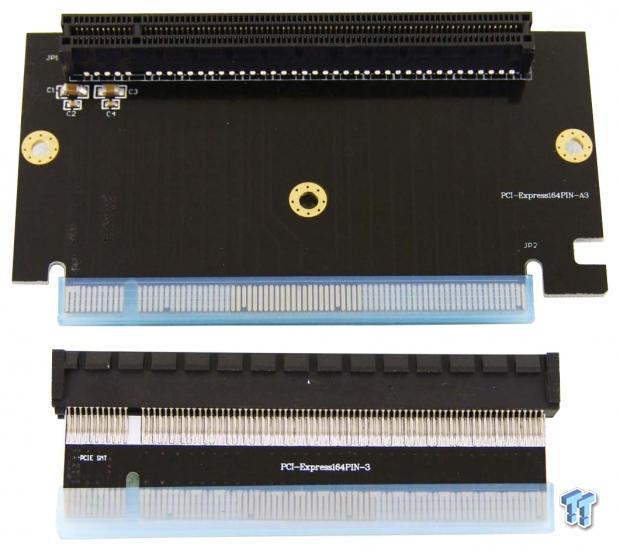
In with the hardware, Fractal Design sends along a pair of PCI-e, hard-card, risers. The larger of the two mounts to the steel part of the chassis, and plugs into the motherboard's slot. The smaller one connects to the large card, and the slot is used to plug in the video card, allowing for the ninety-degree rotation.
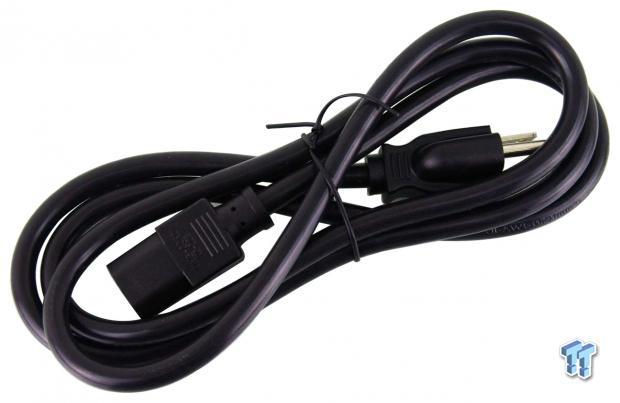
There is also this thick gauge PSU power lead that comes along with the Node 202 when you opt for the Integra PSU.
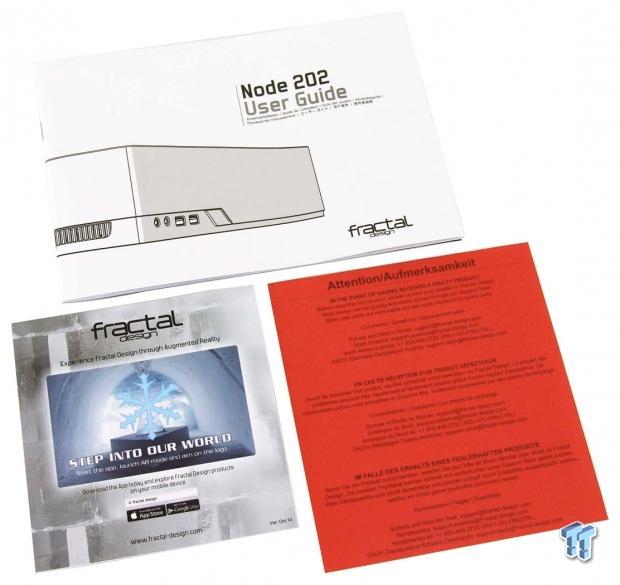
The Node 202 user guide is well done, and with the renderings and text instructions provided, it greatly eases accessibility into the chassis, explains how it all comes apart, and shows how to install all of your gear and accessories. Fractal Design also includes a product guide of everything else they make, along with a bright red insert informing you that if there is damage, you should RMA the chassis and not return it to the store.
Case Build & Finished Product
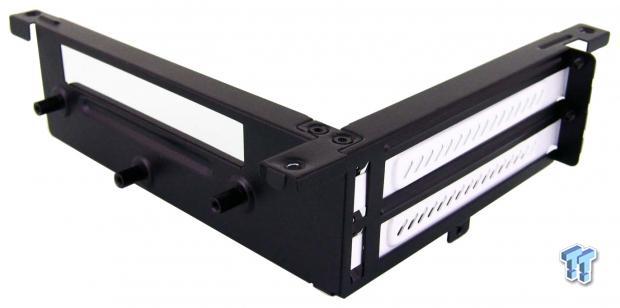
After placing the motherboard and drives into the chassis, the manual shows that the expansion slots and part of the center support needs to be removed to address the GPU installation. Just three screws and a bit of wiggling allowed for this brace to come free of the chassis.
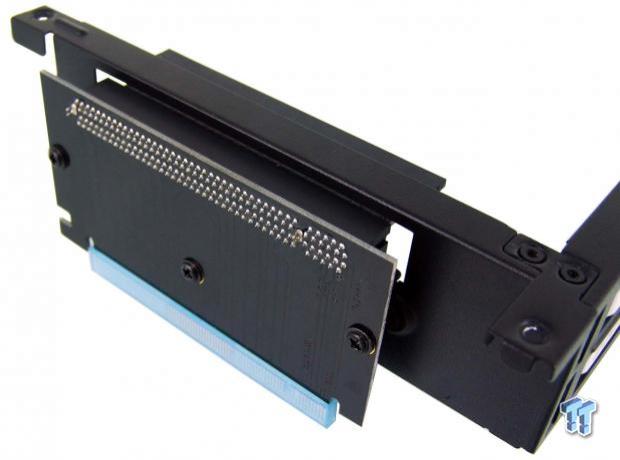
At this point, you need to grab the riser cards. Screw the larger one to the steel via the standoffs, and once that is secured, you plug the smaller riser into the other side.
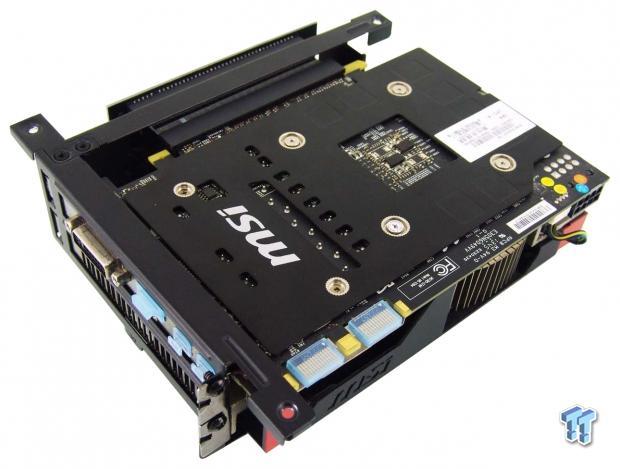
You then remove the expansion slot covers, install the card to the riser, and secure the video card with screws where the slot covers used to reside. It is at this point that you may install this as one unit, back into the Node 202.
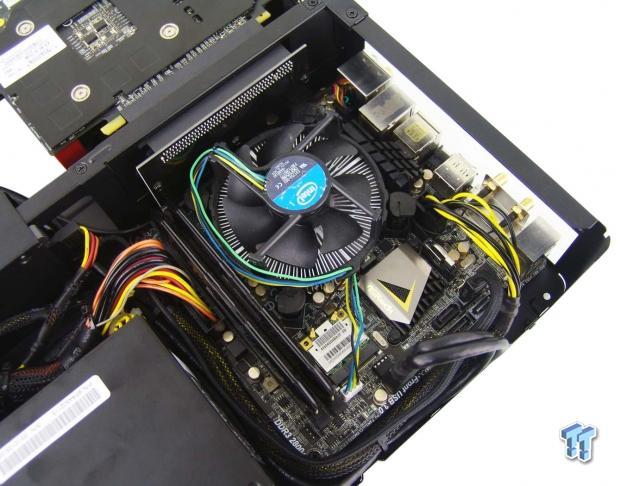
With wire tie points near the PSU and along the outer edge, keeping the wiring tidy and free of the CPU is easy to do. This chassis is designed for stock coolers, but any down-flow style cooler that is less than 56mm tall should suffice as well.

Part of why PSU length can come into play is that the Node 202 has tie points, and with the Integra SFX 450W PSU, we are left with a handy space to bundle what extra wiring we did have to deal with. We also found no issue removing the drive cage, nor getting our SSD installed into it.
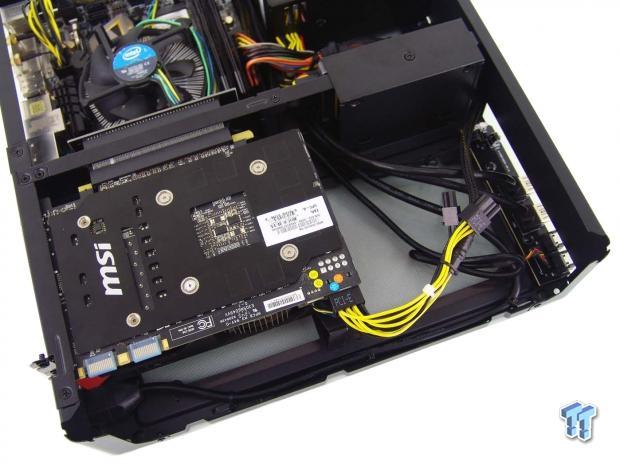
While we have said many times that the longer GPUs will fit, all of our choices have custom coolers and were slightly too long, and is why we opted for the MSI in this chassis. It is easy to ascertain that we found plenty of room for power connectivity, but with cards powered on the end, it may be a bit tricky.

After snapping the metal frame back into the lower section, being mindful of the front I/O connectivity while doing so, and then replacing the top cover, we are back to where this review started. A low-slung, understated, yet sleek chassis which can house a ton of power.

Fitting a dust shield is easy enough, and since the GPU installs from the top, there were no issues with it aligning in the back of the chassis. At this point, we just need to power up the Node 202 and see what we get in testing it out.

Once powered, depending on your component choice, the only way you can tell it is on is by the white, power LED, being lit to the right of the power button. Of course, opting to use an Intel stock cooler inside of this chassis, it was fairly noisy, but the Node 202 is fan-less in design, so we cannot fault it for the noise we did have.
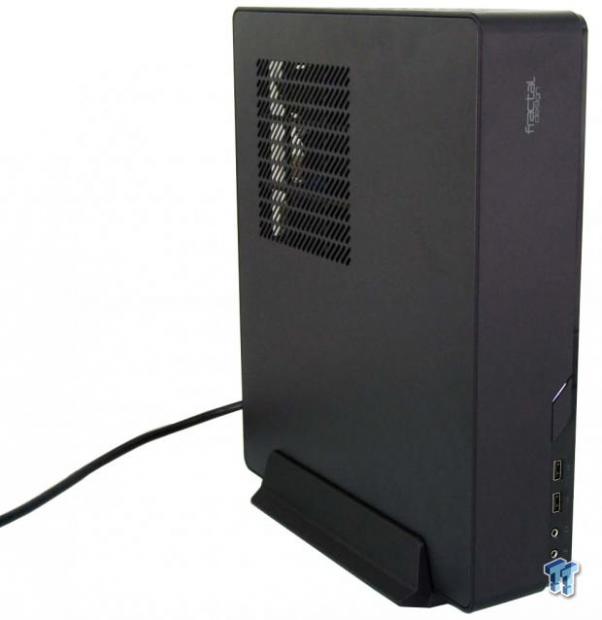
Don't forget. You can also run this Node 202 in the vertical orientation. This way, the video card, PSU, and CPU all draw air in from the sides, and the large side vent is now up top. This allows convection to take place, and all of the heated air should come right out of the top.
Final Thoughts
There are many things to admire when it comes to the Node 202. Whether you opt for their Integra PSU or not, the Node 202 is as solid as it gets. While it may be encased in plastic, there may be tabs holding parts on, and screws sandwiching the exterior together, but at the same time, not one rattle was heard. The wiring is tight to manage, but is very doable, and leaves components unobstructed, allowing everything to breathe as intended in its compartment. While drive installation is limited to 2.5" drives, the rack used is a simple and effective solution, placed well in the design. We also like the use of hard-card risers and the fact that the chassis can be so slim with the video card lying on the same plane as the motherboard. There are the removable dust filters to consider, a GPU support brace that is adjustable, ventilation in all the right places, and even as confined as the parts are in the Node 202, our thermal testing turned out better than we expected.
Every aspect of this design is well thought out, as we cannot come up with one major issue when it came to the build or use of this chassis. We like that this chassis also offers a cradle. Not everyone has room for something with a footprint like a stereo component, but for instances where items are stacked for the HTPC, this Fractal Design chassis will be a stunning addition. Not that it looks any worse in the vertical orientation, in fact, we have had vertically oriented PCs in the past and find them to be very handy. They fit behind things like a TV, can easily stand and not take up a bunch of room, and with a fan-less design such as this, as long as you have the Fractal Design name on the front at the top, convection is your friend, and things inside still stay nice and cool.
For those out there that like to hand pick every item in the build, the $79.99 pricing of the base Node 202 is worth every penny. Of course, you do not get the PSU, but you still get all the performance and appeal that this Node 202 delivers. If it were our money going out the door, we would likely have opted for the inclusion of the PSU for a few reasons. For starters, it only adds $60 to the pricing to do this and is a fair price for a 450W SFX PSU in the first place. Then, of course, there are all the connections needed to fill this chassis completely, without extra leads to tend to. Continuing on a similar line, the Integra our chassis came with has leads that do not require much to manage them cleanly. This means the Node 202 and its compartmentalized interior can breathe freely, and keep you enjoying it for many hours of streaming or hardcore gaming.
Chad's Chassis Test System Specifications
- Motherboard: GIGABYTE GA-Z68X-UD4-B3
- CPU: Intel Core i7 2600K (buy from Amazon)
- Cooler: Corsair H80i GT (buy from Amazon)
- Memory: G.Skill Ripjaws F3-12800CL6D-4GBXH
- Video Card: ZOTAC GeForce GTX 970 AMP. Extreme Edition (buy from Amazon)
- Storage: SuperSpeed 128GB SSD
- Power Supply: SilverStone SST-ST85F-G (buy from Amazon)
- OS: Microsoft Windows 7 Ultimate 64-bit (buy from Amazon)

